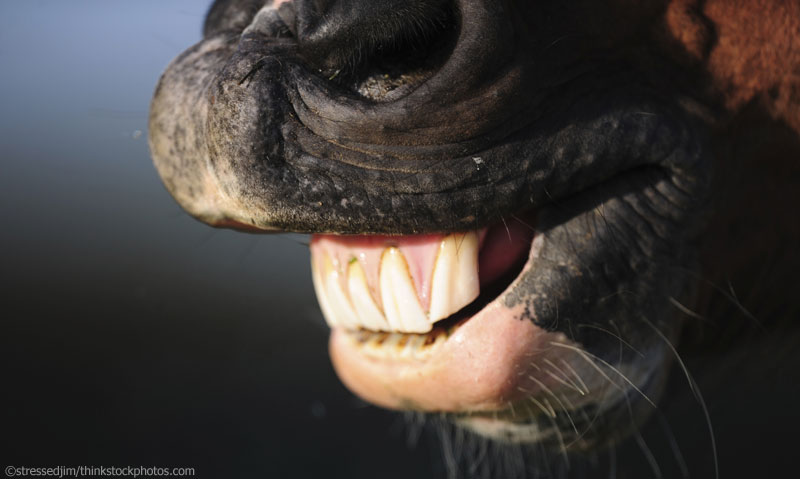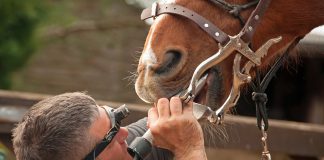
A: I’m afraid my response may not settle the bet because the answer is: sometimes but not always. That is, while male horses are generally more likely to have more teeth than female horses, it’s an individual thing. Therefore, stallions, geldings, and mares can have the same number of teeth or (rarely), an individual mare may have more teeth than the gelding that lives next door to her. A closer look inside the mouth reveals why:
Although few have this many, horses actually have the capacity for 44 teeth by the time they’re an adult! If we just consider the teeth on the top, there are:
- 6 incisors
- 2 canine teeth (1 left, 1 right)
- 2 “wolf” teeth (1 left, 1 right)
- 6 cheek teeth (3 premolars and 3 molars) on the right
- 6 cheek teeth (3 premolars and 3 molars) on the left
- 22 teeth TOTAL on the top
Double this to include the bottom arcade for a grand total of 44 teeth in the mouth of an adult horse. Now let’s talk about each type of tooth individually:
Incisors are the teeth in the front that horses use to bite or tear off grass. While each tooth has a designated “official number”, these teeth may be referred to as central, intermediate, and corner incisors. All horses have the same number of incisors, 12 total (6 on the bottom and 6 on the top).
Canine or “bridle” teeth, also called tusks, are the individual teeth more often seen in geldings and stallions that lie in the interdental or bit space between the corner incisor and the first cheek tooth. Since horses are herbivores or grazing animals, not meat eaters, it is believed the only function of these teeth is for fighting between males of a herd. Canines are not present in every horse, even males, and may occasionally be seen in mares.
“Wolf” teeth, the true first premolar, come next, and typically sit right next to the first large cheek tooth aka second premolar. They do not appear in every horse, may occur only on the top or bottom arcade (or only on the left or right), and may be present but not visible because they did not erupt through the gum (known then as “blind” wolf teeth). Wolf teeth come in all shapes and sizes but are typically much smaller than any of the other teeth. Wolf teeth that are abnormally positioned and may cause bitting issues are extracted, but many performance horses do just fine with normal wolf teeth.
Premolars and Molars together make up the horse’s cheek teeth, the largest teeth in the mouth whose table surfaces meet in a sideways motion to grind food into smaller particles that can be swallowed and digested. All horses have three premolars followed by three molars in each arcade, right and left, top and bottom, for a total of 24 cheek teeth. Because the upper jaw is slightly wider than the lower jaw, the upper and lower cheek teeth don’t meet together perfectly – the upper cheek teeth protrude on the cheek side or outside of the mouth while the lower cheek teeth protrude on the tongue side or inside of the mouth. It is in these areas that sharp enamel points develop as the teeth wear, and these points can cause discomfort secondary to abrasions and ulceration to the cheeks and the tongue.
Incisors have traditionally been used to “age” a horse, although more and more the accuracy of this technique has been called into question. However, because most horses have all of their adult teeth by the age of five years old, it is somewhat possible to estimate the age of a horse from birth to five years. This table provides a general eruption or appearance schedule of the horse’s deciduous (baby or “milk” teeth) as well as permanent or adult teeth:
| Deciduous teeth | Permanent teeth |
| 1st incisors (centrals): birth to first week | 1st incisors (centrals): 2 ½ years |
| 2nd incisors (intermediates): 4-6 weeks | 2nd incisors (intermediates): 3 ½ years |
| 3rd incisors (corners): 6-9 months | 3rd incisors (corners): 4 ½ years |
| 2nd premolars: birth to first 2 weeks | 2nd premolars (1st cheek teeth): 2 ½ years |
| 3rd premolars: birth to first 2 weeks | 3rd premolars (2nd cheek teeth): 3 years |
| 4th premolars: birth to first 2 weeks | 4th premolars (3rd cheek teeth): 4 years |
| None | 1st molars (4th cheek teeth): 9 to 12 months |
| None | 2nd molars (5th cheek teeth): 2 years |
| None | 3rd molars (6th cheek teeth): 3 ½ to 4 years |
| None | Wolf teeth (1st premolars): 5 to 6 months |
| None | Canines (bridle teeth): 4 to 5 years |
Although it is important to note that not every horse “reads the book” and therefore eruption ages may vary, many horsemen use the saying “6 days, 6 weeks, 6 months” to remember how old foals and weanlings generally are when their deciduous incisors come in. Likewise, “2 ½, 3 ½, and 4 ½” is an easy way to remember when the permanent incisors come in.
This may have been more info that you were looking for, but at least now you and your friend have an accurate picture of the inside of the equine mouth in all its variations.






